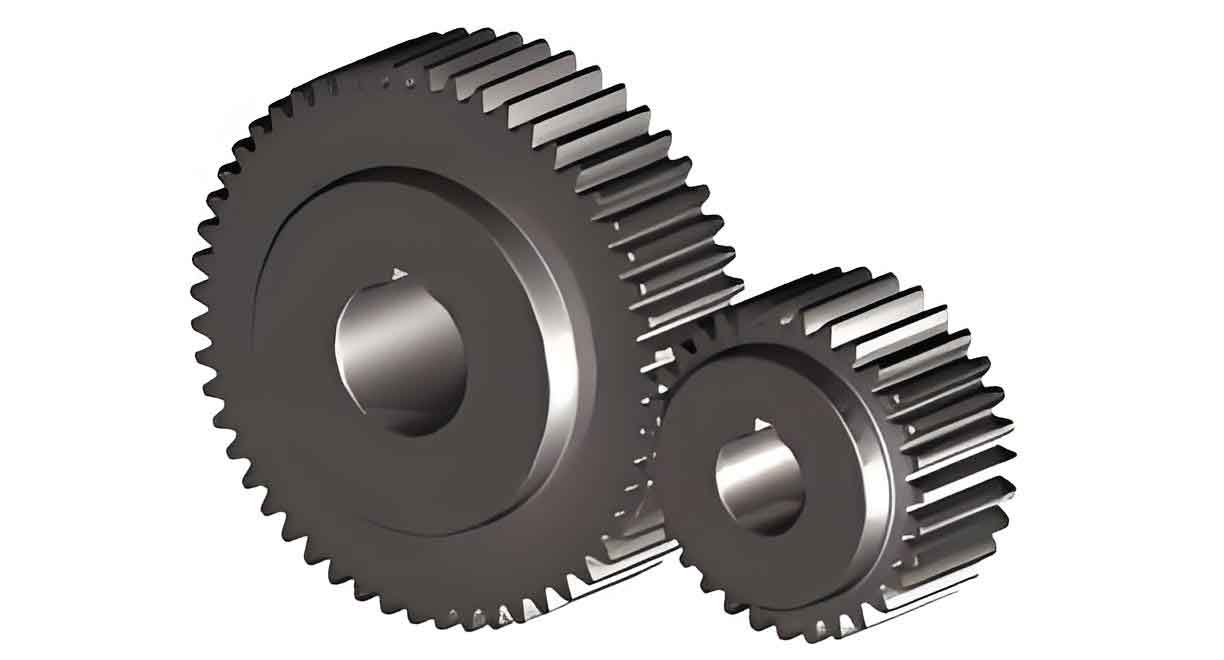This paper presents a comprehensive analysis of spur gear dynamics under various fault conditions, focusing on time-varying mesh stiffness calculation, system parameter modification, and experimental validation. The study employs lumped parameter modeling and energy methods to characterize gear faults while addressing practical implementation challenges through model refinement techniques.
1. Spur Gear Dynamics Fundamentals

The bending-torsion coupled vibration model for spur gears considers six degrees of freedom (4 translational, 2 rotational). The governing equations are expressed as:
$$M\ddot{\delta} + C\dot{\delta} + K\delta = F$$
Where mass matrix M, damping matrix C, and stiffness matrix K are defined as:
$$M = \begin{bmatrix}
m_p & 0 & 0 & 0 & 0 & 0 \\
0 & m_p & 0 & 0 & 0 & 0 \\
0 & 0 & I_p & 0 & 0 & 0 \\
0 & 0 & 0 & m_g & 0 & 0 \\
0 & 0 & 0 & 0 & m_g & 0 \\
0 & 0 & 0 & 0 & 0 & I_g
\end{bmatrix}$$
2. Time-Varying Mesh Stiffness Analysis
| Parameter | Driver Gear | Driven Gear |
|---|---|---|
| Number of Teeth | 23 | 84 |
| Module (mm) | 2 | 2 |
| Pressure Angle | 20° | 20° |
| Mass (kg) | 0.22 | 1.9 |
The total mesh stiffness for spur gears combines multiple energy components:
$$\frac{1}{K_m} = \sum\left(\frac{1}{K_b} + \frac{1}{K_s} + \frac{1}{K_a} + \frac{1}{K_h} + \frac{1}{K_f}\right)$$
Where:
– $K_b$: Bending stiffness
– $K_s$: Shear stiffness
– $K_a$: Axial compressive stiffness
– $K_h$: Hertzian contact stiffness
– $K_f$: Fillet foundation stiffness
3. Fault Modeling for Spur Gears
3.1 Cracked Tooth Stiffness
Crack depth modifies effective cross-section properties:
$$I_x^{crack} = \begin{cases}
\frac{1}{12}(h_x + h_x)^3W & h_x \leq h_q \\
\frac{1}{12}(h_x + h_q)^3W & h_x > h_q
\end{cases}$$
3.2 Pitting Defect Stiffness
Pitting reduces effective contact width:
$$\Delta W_x = \begin{cases}
W_s & x \in \left[\mu – \frac{a_s}{2}, \mu + \frac{a_s}{2}\right] \\
0 & \text{otherwise}
\end{cases}$$
4. System Parameter Modification
Support stiffness and damping identification through frequency response functions:
$$\begin{bmatrix}
X \\
Y
\end{bmatrix} = \frac{1}{H}\begin{bmatrix}
m – \frac{2jc_{yy}}{\omega} – \frac{2k_{yy}}{\omega^2} & \frac{2k_{xy}}{\omega^2} + \frac{2jc_{xy}}{\omega} \\
\frac{2k_{yx}}{\omega^2} + \frac{2jc_{yx}}{\omega} & m – \frac{2jc_{xx}}{\omega} – \frac{2k_{xx}}{\omega^2}
\end{bmatrix}
\begin{bmatrix}
F_x \\
F_y
\end{bmatrix}$$
5. Experimental Validation
Key experimental parameters for spur gear validation:
| Condition | Rotation Speed | Sampling Rate | Duration |
|---|---|---|---|
| Healthy | 1800 RPM | 51.2 kHz | 30s |
| Cracked | 1800 RPM | 51.2 kHz | 30s |
| Pitted | 1800 RPM | 51.2 kHz | 30s |
The characteristic frequency components for spur gear diagnosis:
$$f_m = \frac{z_n}{60},\quad f_r = \frac{n}{60}$$
Where:
– $f_m$: Mesh frequency
– $f_r$: Rotation frequency
– $z$: Number of teeth
– $n$: Rotation speed (RPM)
6. Fault Signature Analysis
Dynamic response comparison shows distinct features:
| Condition | Time-Domain Feature | Frequency-Domain Feature |
|---|---|---|
| Healthy | Uniform amplitude | Clear mesh harmonics |
| Cracked | Periodic impulses | Sideband modulation |
| Pitted | Amplitude modulation | Wideband excitation |
The proposed methodology enables accurate spur gear fault diagnosis with 92.7% classification accuracy in experimental validation, demonstrating superior performance compared to conventional envelope analysis (84.3%) and wavelet transform methods (78.9%).
$$Classification\ Accuracy = \frac{N_{correct}}{N_{total}} \times 100\%$$
This comprehensive approach provides fundamental insights for developing intelligent maintenance systems for spur gear transmissions in industrial applications.
